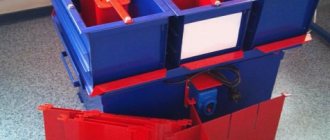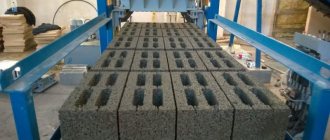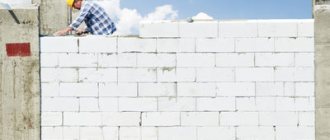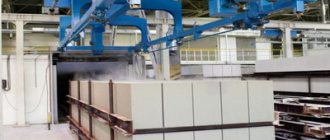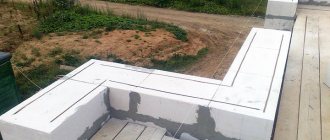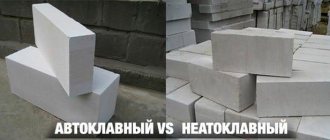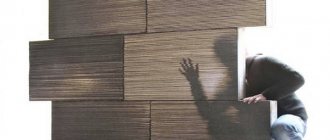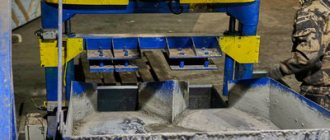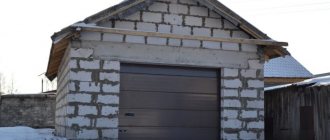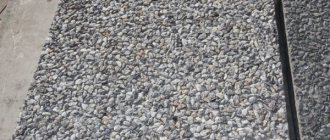The technology on which modern production of gas silicate blocks is built today was invented back in the last century in Sweden. At that time it was not widely used, but after changes over time, the reliability of the material increased, as well as its convenience and ease of creation.
Features of the technology
The main point of producing gas silicate blocks is to create a silicate mixture, to which aluminum powder is then added. Due to the resulting reaction between the components, silicate foam appears. After autoclave treatment, it increases its strength. The result is a product that is cut into finished blocks of the required size. A special feature of such products is the use of only natural and environmentally friendly materials for their preparation. Therefore, products obtain their properties by mixing cement, sand, lime, as well as gypsum with aluminum powder.
A popular way to start the gas formation process is to add ordinary aluminum powder to the solution. Sometimes other components are used.
The lime reaction that occurs after the addition of aluminum powder leads to foaming of the solution, which makes it possible to obtain a porous structure of the material. And the use of special equipment makes it possible to regulate the pore size, as well as obtain gas silicate blocks with different characteristics. In addition, the technology for producing gas silicate blocks is simple and does not involve large expenses for creating a small production. But if you spend some money, the whole process can be automated and consist of high-tech lines.
When producing gas silicate blocks, their density, cell size, as well as other parameters can be changed by adjusting the composition, taking into account strict adherence to proportions. After creating the mixture itself, it is left in the mold for 4 hours, where the process of pore formation occurs at a temperature of 40 °C. The operating parameters of products depend directly on the quality of all stages of its production. The advantage of this technology is that it is completely waste-free.
When gas silicate is produced on its own, achieving maximum evenness of the product is extremely problematic. In this case, milling units are used.
To enhance the strength characteristics of the material, it is placed in autoclaves, which are special chambers where products are subjected to heat treatment under high pressure conditions. If this is not done, then the finished blocks will have lower rigidity values.
What technology is used to produce gas silicate?
Technological scheme for the production of gas silicate blocks
The production of gas silicate blocks at home, from the point of view of the technology itself, differs little from the production process on the basis of a full-fledged workshop - the difference here is greater in the volume of products produced and the quality of raw materials.
The raw materials used to make the material are publicly available and inexpensive, which naturally is reflected in the low cost of the finished product.
What kind of raw material base does the entrepreneur need to prepare?
- quartz sand,
- quicklime,
- Portland cement,
- water,
- aluminum paste.
To minimize the cost of purchasing raw materials, it is better to cooperate with direct wholesale suppliers who are located as close as possible to the production workshop.
The production technology of gas silicate blocks includes the following stages:
- Preparation of components (sifting, dosing).
- Mixing sand and water to produce sludge.
- Mixing sludge, cement, lime and aluminum.
- Pouring the raw material into molds.
- Baking the mixture in an autoclave.
- Cutting slabs into blocks of certain sizes.
Both the manufacture of gas silicate blocks with your own hands and the production of products in a well-equipped workshop always begin with a precisely verified recipe. Each company keeps its recipe secret, and therefore, getting it somewhere “outside” will be quite problematic. In order not to waste a lot of time in experiments to create the “ideal” gas silicate, it would be advisable to resort to the services of a qualified technologist.
Raw materials for production
Each gas silicate block weighs about 30 kg, due to which it can replace up to 30 standard bricks. But to create such large products, it is necessary to prepare an appropriate amount of materials. So, for their production you need:
- Lime, which is highly saturated with calcium and magnesium oxides;
- Portland cement, which contains more than 50% calcium silicate;
- High-quality quartz sand containing more than 80% pure quartz;
- Aluminum powder necessary to create a gas formation reaction;
- Sulfanol;
- Clean drinking water.
Equipment for the production of
To open your own small production of gas silicate blocks, you need to study existing offers on the market for all types of equipment necessary to create an enterprise. The fact is that the quality of the products that will be produced largely depends on the level of manufacturability of the production line. So, to produce blocks you need to purchase:
- A device through which the mixture will be poured and given the required dimensions;
- Equipment used for cutting finished blocks;
- Electronic water dispenser;
- A set of dispensers used for bulk raw materials;
- Special mixers-activators;
- A unit for mixing all ingredients.
It is important to note that an autoclave (a device for firing products under high pressure) is not a mandatory element of the production line. In addition, its cost starts from 1.2 million rubles, which is a huge amount for creating a small private production and exceeds the cost of all other elements. Without it, a material of medium and low hardness with appropriate performance properties is created. Large plants producing gas silicate blocks consist of a clear and automated line, which includes the following systems:
- Crushing materials and carrying out their dosage;
- Mixing components and conductive pouring of the solution into molds;
- Slicing finished products;
- Increasing the strength of gas silicate blocks (it includes an autoclave);
- Packaging finished products.
Moreover, all models operate in automatic mode and are controlled by a central processing unit. Through it, the operator sets the necessary parameters of the building material being produced. Therefore, it is not advisable to buy each of the elements separately to create a more or less large production line. There are kits of different productivity, varying in daily production volume, which is 10-150 cubic meters. The best are considered to be conveyor-type lines that have low cost, but at the same time high productivity, which makes them highly profitable.
To purchase high-quality equipment for the production of gas silicate blocks, you should carefully approach the choice, comparing different options in terms of productivity and quality. You also need to take into account reviews from other entrepreneurs.
Equipment for gas silicate blocks
The cost of a plant for the production of gas silicate blocks with a capacity of 50,000 m3/year, including installation and commissioning, is about $1,189,000
You can buy equipment for the production of gas silicone blocks by contacting the consultants of our company, or ask all questions directly to the manufacturer. To check the quality of the finished equipment and clearly evaluate its advantages, we suggest you visit directly the Chinese manufacturer of this equipment. We are absolutely confident in what we offer to our customers. The manufacturer offers a warranty and service for all equipment parts.
What are gas silicate blocks?
Gas silicate blocks are a new generation material.
To achieve the best quality and optimal cost of materials for buildings, several completely unique materials were created. Building materials such as gas silicate blocks make it possible to achieve greater reliability and durability of buildings. The main problem of all building materials is frost resistance. With each new season, the walls of your home “wear out.” This is due to the fact that during cold and thaw periods, liquid accumulates in the pores of the building material that makes up the walls of the building. With each new season, the walls are being destroyed more and more. After 50 years, cracks and creeps are already appearing in the house. Construction from gas silicate blocks allows you to extend the service life of the building to 150 years. The pores of the blocks are not completely filled with water, so when temperatures change, the destruction of the walls will be minimal. Gas silicate blocks are less thermally conductive. When building a brick house, you will additionally need insulation, and the thickness of the layer will directly depend on the thickness of the brickwork. When using porous materials, a small layer is sufficient for any wall thickness. In addition, air pores in gas silicate blocks create additional sound insulation, and special production technology and high-quality materials make it possible to increase resistance to external and internal environmental influences. The small volume of production of gas silicate blocks allows new entrepreneurs to enter the market with minimal competition. At the moment, the construction sector is relevant and does not depend on the economic situation of the country.
Construction companies in Russia and the CIS often use more expensive imported goods for their work, since domestic manufacturers do not produce enough gas silicate blocks, foam concrete slabs, bricks and other building materials. An average plant of gas silicate blocks can fully supply a large construction organization. China produces not only high-quality equipment that allows you to create competitive products, but also allows you to set up production at minimal cost.
Equipment from China is 15% more economical and productive; it is designed for operation in 3 work shifts at maximum workload.
High quality materials and precise assembly technology allow us to fine-tune the operation of all equipment down to the mechanism. The high quality of materials used in production allows us to extend the service life of machines and improve the final product. The latest technologies and constant modernization allow you to save maximum time and costs when using a line for the production of gas silicate blocks. If you decide to organize the production of gas silicate blocks, our company can offer you its own. It is a full representative of leading Chinese engineering companies and supplies equipment to the CIS countries .For the production of high-quality gas silicate blocks, modern technological equipment is required. If you are interested in modern equipment for the production of gas silicate blocks, please contact us.
Production stages
The creation of building material itself occurs in the following sequence:
- First you need to prepare all the components;
- Next, the filling mixture is made;
- Blocks are formed and solidified;
- Cutting material into products of the required size;
- Processing blocks in an autoclave;
- Packaging of finished aerated concrete.
Each stage should be considered in more detail.
Preparation of materials
To prepare 1 cu. m of mixture, you need to prepare the components in the following proportions:
- Water in a volume of 450 l.;
- Lime - 120 kg, but not more than 20% of the total volume;
- Cement – 60 kg, the content of which in the solution is approximately 10%;
- Quartz sand – 450 kg, with a quartz content of more than 80%;
- Gypsum – 500 g, 2nd class;
- Aluminum powder – 500 g.
To achieve the best density of gas silicate blocks, the proportion of pores in them should be no more than 38%. This will allow the products to be used for the construction of permanent structures. Medium-density products have up to 52% voids, and the lightest options contain up to 92% pores. They are used only as a thermal insulation material.
Making the mixture
When the components are prepared, you need to sift the quartz sand and then grind it in a ball mill. After this, water is added to it. All this is fed into an aerated concrete mixer. The remaining components are sequentially added there, bringing their content to the required consistency. Next, aluminum powder is introduced into the solution, after which the composition is mixed.
Monitoring compliance with proportions should not be carried out independently; this must be entrusted to the electronic control system for greater accuracy.
Molding
The resulting mixture is poured into pre-prepared molds, where it is kept at an air temperature of 40 °C for about 4 hours. During this time, the mass rises, similar to yeast dough, which is due to the release of gas. The process continues until the maximum swelling mass is reached, when the formation of hydrogen ends. Then the products are aged for another hour to gain plasticity.
A distinctive parameter of gas silicate is its color. It only comes in white with a uniform structure. Therefore, if, under the guise of such products, they offer to purchase blocks of a darker color, most likely, they are offering classic foam blocks.
Solid cutting
To obtain gas silicate blocks, it is necessary to process all surfaces of the material. First, the side parts are removed using special knives. If necessary, a tongue-and-groove system is formed. Next, vertical as well as horizontal cutting is performed using tensioned strings. All waste resulting from this process is used to re-prepare the mixture, making the process waste-free.
Autoclave processing
The autoclave itself is a steam chamber where blocks are processed at high humidity and under high pressure. Through the use of such equipment for the production of gas silicate, the strength properties of the material are improved, becoming denser, lighter and smoother. A pressure of more than 12 atmospheres is created in the chamber for 12 hours, and a temperature of 180 °C is pumped up. After this, the pressure is reduced and the finished products are removed from the autoclave.
Package
The finished products are laid out on the prepared surface until they cool completely. Further packaging is carried out using an automatic line that prevents the formation of dirt or chips on the surface of the gas silicate blocks. They are supplied for sale already sealed and ready for use.
Most manufacturers of gas silicate blocks in Russia prefer automated lines. This is due to the high quality, speed and lower costs of creating such building material. Automation copes better with routine processes and clearly follows the proportions of components and the sequence of actions.
